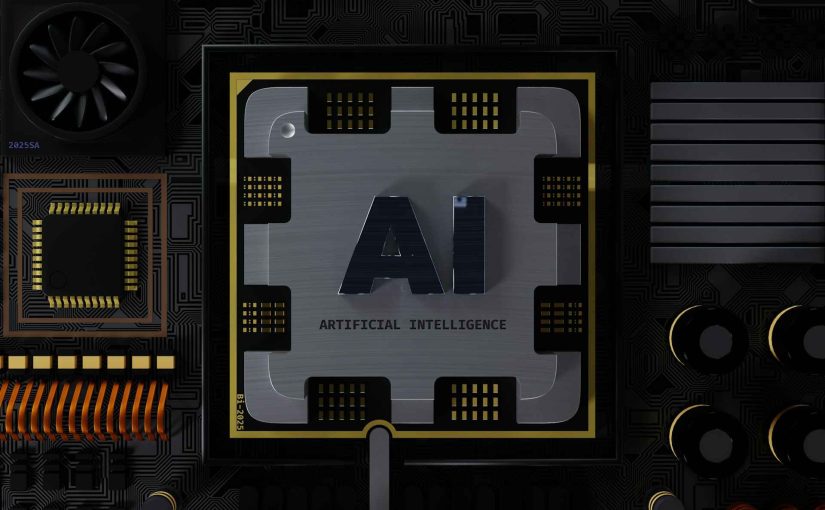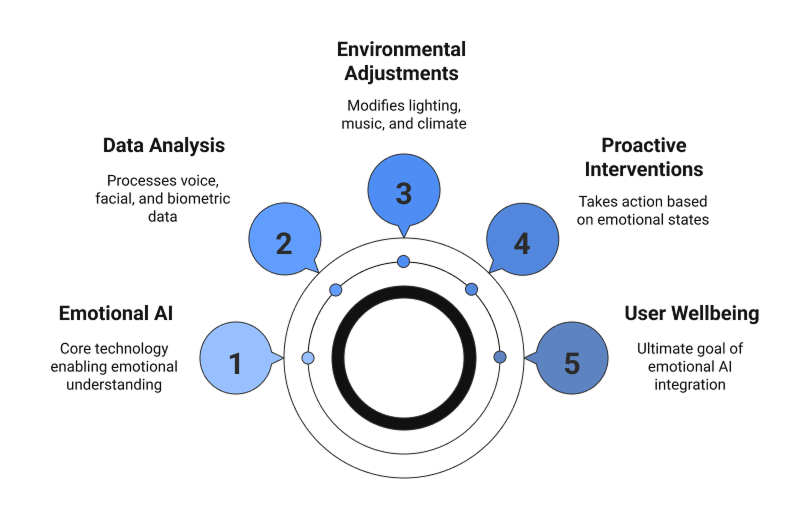
The smart home revolution isn’t coming – it’s here, and artificial intelligence is separating market leaders from the competition. While the average home now contains 25+ connected devices, 95% of users report frustration with disconnected, manual automation. The winners are building AI that anticipates needs, learns preferences, and creates seamless experiences across entire ecosystems.
Key Insight: Companies implementing AI-driven features consistently see significantly higher user engagement and improved customer retention compared to basic smart devices.
This is the first of a three-part series “AI in Smart Home Devices”, and in this installment, we’ll dive into the specific AI features poised to drive market success from 2025 to 2027, complete with insights from real-world deployments serving millions of users.
Why AI Integration Will Make or Break Smart Devices in 2025
AI is no longer a nice-to-have – it’s a dealbreaker. Leading products use AI to deliver smarter, more personalized experiences – and consumers are rewarding them:
- 40–60% higher price tags for premium devices with strong AI features
- 73% of users say they’d switch brands for better AI functionality
- Voice-first interfaces are now expected in 85% of smart home categories
- Cross-device intelligence is emerging as the top driver of ecosystem loyalty
Poorly implemented AI does more harm than good. Clunky voice recognition, irrelevant suggestions, or intrusive automation can frustrate users and erode trust. Privacy concerns only amplify the backlash.
But when done right, AI transforms a smart device from a passive tool into a truly helpful companion – one that listens, learns, and adapts to the user’s life.
Future AI Features to Watch (2025–2027)
The trajectory of AI development in audio and smart home devices points toward increasingly sophisticated capabilities that will fundamentally change how we interact with our living environments. Understanding these emerging trends is crucial for manufacturers planning product roadmaps and developers preparing for next-generation implementation challenges.
Emotional AI and Wellbeing Integration
The next generation of smart home and audio devices will incorporate sophisticated emotional intelligence that goes far beyond current mood detection capabilities. These systems will analyze subtle patterns in voice tone, facial expressions captured by security cameras, sleep quality data from smart beds, and even biometric information from wearable devices to create comprehensive wellness profiles.
Advanced implementations will recognize early signs of stress, depression, or anxiety, then automatically adjust environmental conditions to support mental health. The system might increase natural light exposure during periods of low mood, adjust music selections to include scientifically-proven mood-lifting compositions, or modify temperature and humidity to optimize comfort during times of emotional distress.

By 2027, we expect to see audio devices that can detect emotional states through vocal pattern analysis with 95%+ accuracy, enabling proactive interventions that could significantly impact user wellbeing. Smart home systems will coordinate lighting, temperature, air quality, and acoustic environments to create therapeutic spaces that support recovery from stress and promote overall mental health.
Advanced Biometric Integration
The integration of sophisticated biometric monitoring into everyday devices will create unprecedented opportunities for health-focused AI features. Smart earbuds will monitor heart rate variability, body temperature, and stress hormones through ear canal sensors, while smart home devices will track sleep patterns, respiratory rates, and activity levels through non-contact monitoring technologies.
These biometric capabilities will enable predictive health features that could identify potential medical issues days or weeks before symptoms become apparent. Smart home systems might detect changes in gait patterns that suggest developing mobility issues, or identify respiratory pattern changes that could indicate the onset of illness.

Img 2 : Future of Biometric Integration in Smart Devices
By 2026, we anticipate audio devices with built-in health monitoring capabilities that rival dedicated medical devices, while maintaining the convenience and user experience expectations of consumer electronics. This convergence will require sophisticated AI systems that can distinguish between normal variations and concerning changes while avoiding false alarms that could cause unnecessary anxiety.
Predictive Maintenance and Self-Healing Systems
The complexity of modern smart home ecosystems creates significant challenges for maintenance and troubleshooting. Future AI systems will incorporate sophisticated predictive maintenance capabilities that identify potential failures before they impact user experience, automatically order replacement components, and in some cases, reconfigure systems to work around failing components.
Advanced implementations will include self-healing capabilities where systems can automatically adjust parameters, redistribute processing loads, and modify operation patterns to compensate for degrading components. A smart speaker with a failing driver might automatically adjust EQ settings to maintain audio quality, while coordinating with other speakers in the home to redistribute audio responsibilities.
By 2027, we expect smart home systems that can maintain optimal performance for 5-7 years with minimal human intervention, automatically managing software updates, hardware optimization, and component replacement scheduling to ensure consistent user experiences throughout the product lifecycle.
Hyper-Personalization Through Behavioral AI
Future AI systems will move beyond current personalization approaches to create truly individualized experiences that adapt to subtle changes in preferences, habits, and life circumstances. These systems will understand not just what users prefer, but why they prefer it, enabling adaptation to changing life situations like new jobs, family changes, or evolving health conditions.
Advanced behavioral AI will recognize patterns that users themselves might not be aware of, creating experiences that feel almost telepathic in their accuracy. The system might detect that user music preferences shift predictably with weather patterns, work stress levels, or seasonal changes, then proactively adjust recommendations and automated playback to match these subtle influences.
By 2026, we anticipate AI systems that can create unique user profiles encompassing thousands of behavioral variables, enabling personalization that adapts continuously to life changes while maintaining privacy through advanced federated learning approaches that keep personal data distributed and encrypted.
Ambient Computing and Invisible Interfaces
The future of smart home and audio AI lies in systems that become so seamlessly integrated into daily life that conscious interaction becomes unnecessary. Ambient computing will enable devices to understand user intent through subtle cues like body language, vocal patterns, and environmental context, responding appropriately without explicit commands.
These systems will recognize that a user picking up car keys while looking at their phone suggests departure preparation, automatically adjusting home systems for away mode while ensuring phone charging is complete and navigation apps have current traffic information. Audio systems will understand that users reaching for headphones during video calls indicates a need for private audio, automatically coordinating device handoffs and audio routing.
By 2027, we expect smart environments where conscious device interaction becomes the exception rather than the rule, with AI systems that understand human intent through environmental context and behavioral patterns, creating truly ambient intelligence that enhances daily life without requiring attention or management.
Cross-Device AI – Creating a Cohesive Smart Ecosystem
The true power of AI in modern homes emerges not from individual smart devices, but from the intelligent coordination between multiple systems working together as a unified ecosystem. Cross-device AI represents the next evolution in home automation, where devices share contextual information, coordinate responses, and create experiences that are greater than the sum of their individual capabilities.

The challenge of cross-device AI lies in managing the complexity of multiple data streams, diverse communication protocols, and varying processing capabilities while maintaining the responsiveness and reliability that users expect from individual devices. Success requires sophisticated orchestration systems that can make split-second decisions about which devices should respond to situations, how they should coordinate their actions, and when human intervention might be necessary.
Contextual Intelligence Sharing
Modern smart ecosystems excel when devices can share contextual understanding rather than just raw data. When a smart doorbell detects a package delivery, it doesn’t just record video – it communicates with the smart lock to temporarily disable entry alerts, notifies the security system that expected activity is occurring, and signals the smart speaker to announce the delivery to household members. This level of coordination requires AI systems that understand the meaning and implications of events, not just their occurrence.
The most sophisticated implementations go beyond simple if-then logic to understand complex scenarios. The system learns that when the smart thermostat detects rapid temperature changes, it might indicate windows or doors being left open, prompting security cameras to verify entry points and smart speakers to gently remind occupants about energy efficiency. This contextual intelligence transforms individual device capabilities into comprehensive home awareness.
Adaptive Response Coordination
Cross-device AI shines in its ability to coordinate responses that adapt to changing circumstances and user preferences. When the security system detects unusual activity, the response isn’t predetermined – the AI considers factors like time of day, household occupancy, historical context, and user-defined priorities to orchestrate appropriate actions. During daytime hours with family present, the response might involve gentle alerts and increased monitoring. Late at night with the house empty, the same trigger could activate full security protocols including lighting, camera recording, and immediate notifications.
This adaptive coordination extends to comfort and convenience scenarios as well. The system learns that family movie nights require dimmed overhead lighting, optimized audio levels from the soundbar, and adjusted climate control to account for increased occupancy. Rather than requiring manual scene activation, the AI recognizes patterns and automatically coordinates multiple devices to create the desired environment.
Predictive Ecosystem Behavior
The most advanced cross-device AI implementations move beyond reactive coordination to predictive behavior that anticipates needs before they’re expressed. The system might recognize that Sunday afternoon cooking sessions typically require enhanced kitchen ventilation, bright task lighting, and background music, prompting automatic coordination between range hoods, smart lighting, and audio systems before cooking begins.
This predictive capability becomes particularly powerful when systems learn seasonal and long-term patterns. The AI might recognize that the approach of winter consistently requires coordination between heating systems, humidity control, and lighting schedules to maintain comfort while managing energy costs. By learning these patterns, the system can begin seasonal adjustments weeks in advance, creating smooth transitions that users barely notice.
Privacy-Preserving Data Fusion
One of the most significant challenges in cross-device AI is combining data from multiple sources while maintaining user privacy and system security. Advanced implementations use federated learning approaches where devices share insights and patterns rather than raw data. The smart thermostat might share learning about occupancy patterns without revealing specific times when the house is empty, while security cameras contribute behavioral analysis without transmitting identifiable images.
This privacy-preserving approach enables powerful ecosystem intelligence while ensuring that sensitive personal information remains protected. The system can coordinate responses based on comprehensive situational awareness without creating central repositories of detailed personal data that could be compromised or misused.
Fault-Tolerant Ecosystem Intelligence
Robust cross-device AI systems must continue functioning intelligently even when individual components fail or lose connectivity. The most sophisticated implementations distribute intelligence across multiple devices, ensuring that core functionality remains available even if primary coordination hubs become unavailable. When the main smart home controller loses internet connectivity, individual devices can continue operating based on cached behavioral patterns and local intelligence.
This distributed intelligence approach also enables graceful degradation of features rather than complete system failures. If smart speakers lose voice recognition capabilities, the system might shift to mobile app controls or physical switches while maintaining automation routines that don’t require voice interaction.
What’s Next: Audio AI in the Real World
As we look towards 2025-2027, it’s clear that the evolution of smart devices will be defined by their ability to understand, anticipate, and adapt. From emotionally intelligent systems that enhance our wellbeing to self-healing devices that require minimal intervention, AI is transforming our living spaces into truly intuitive environments. The integration of advanced biometrics, hyper-personalization, and ambient computing promises a future where technology fades into the background, seamlessly enhancing our daily lives.
The true potential of these individual AI features, however, is unleashed when devices work together. In Part 2 of our series, ‘Integrating AI-Driven Features into Audio Devices,’ we’ll explore how AI is revolutionizing personal and home audio, turning headphones, smart speakers, and home theater systems into intelligent companions that adapt to every listening scenario.
Stay tuned to discover how cross-device AI creates cohesive, intelligent ecosystems that truly elevate your audio experience.






